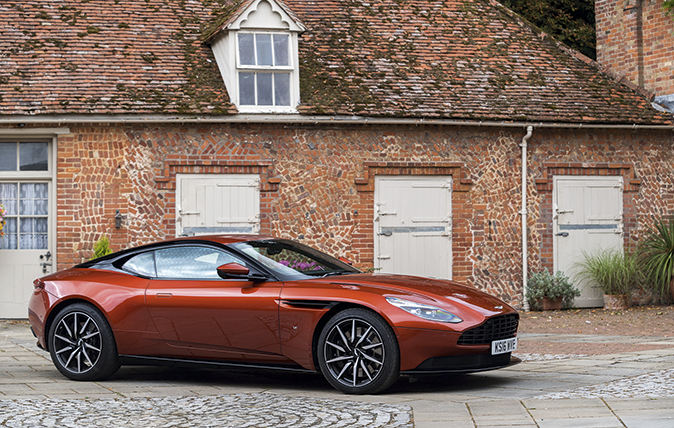The redesigned Aston Martin DB11: car review
Still unmistakably an arresting Aston Martin, the redesigned DB11 is more predatory than the DB9 and rakish enough for Daniel Craig’s 007, finds Charles Rangeley-Wilson.


New Aston CEO Andy Palmer has described the DB11 as ‘the most important car in Aston Martin’s history’. Sure. That and every other Aston upon which the hopes of a buoyant renaissance and financial future have been invested. Aston would not be Martin if it wasn’t selling the world’s most desirable, soulful, quintessentially British, expensively over- engineered and intriguingly flawed cars at eye-watering prices that, nevertheless, don’t ever make the marque comfortably profitable.
Lionel Martin set the mould in the early 1920s, when, on the back of remarkable motor-sport success, he went into production making precision-perfect sports cars at such a level of build quality that, after car number 50 or so, he ran out of money. This was act one. Acts two, three, four, five, six and seven have all played out ‘the same way.
Happily, today’s Aston Martin, supported by a consortium of new owners, including Mercedes Benz, and with a fresh injection of development cash, is not about to run dry, but, even so, there’s a lot riding on the DB11. Every red- blooded petrol head has been droolingly impatient for its appearance. The DB11 is the first in Andy Palmer’s master plan to revive the marque’s fortune. The changes are cumulative, each one relatively subtle, but, overall, this is much more revolution than evolution. The DB11 sets the bar.
First impressions are of breath- taking beauty. Still unmistakably Aston, the DB11 is more predatory than the DB9 and ever so slightly rakish. The folds are sharper, the haunches leaner. It looks pumped. Not quite Raffles the gentleman thug, but definitely more a Daniel Craig kind of Aston. As well as some great riffs on iconic styling cues, such as the aero-inspired strakes coming off the front wheel arches, I feel there’s also a touch of the DB4GT Zagato about the new DB11, especially those racehorse wheel arches, and that’s no bad thing at all, the Zagato being just about the most beautiful post- Second World War car ever built.
Inside, the story is still good, although not as universally great. There’s more space and a feeling of space, too, with curving, sculpted surfaces giving an organic, warmly enveloping feel. Everything feels reassuringly solid: the steering- wheel buttons, the door handles and the gearshift paddles, which ting like a tuned instrument if you tap them. I loved the brogued leather and the sparing use of aluminium to highlight edges.
Sadly, I didn’t love the driving position. It was my lower back that let on, after an hour in the saddle, that my legs were canted to one side. Not by much, but when my throttle leg went numb, it was enough to spoil the party.
This was a hard one to call, because the fault, I’m sure, must have been the position behind the front axle of that volcanically sexy force of nature—the sublime 5.2-litre, quad-cam, twin-turbo V12, which, at 5000rpm, sounded like the rapture, the birth of the universe and all God’s celestial choirs hitting the same frenetic crescendo in unison.
Sign up for the Country Life Newsletter
Exquisite houses, the beauty of Nature, and how to get the most from your life, straight to your inbox.
I can’t tell you how much fun it was to knock the paddle into manual, notch down two gears and ride that rpm curve like a surf- board. Well, almost as much fun as starting her up on a cool, quiet morning in the countryside. My engine gallery of dreams had never included a V12—it’s just too Rococo, too many cylinders. A V-twin, flat four, straight six V8 is all a perfect world really needs, but I’m on the edge of a revision—I am seeing the light.
With 600bhp ready for service under the right foot, this is the most powerful road-going Aston ever. It can spin the wheels in pretty much any gear at any speed. On the rain- soaked, sugar-beet-strewn roads of north Norfolk, I learned to be careful with the throttle. It just wasn’t built for those kinds of byways.
For all its simmering power and ‘did-you-spill-my-pint?’ styling, the DB11 is a grand tourer in the grand tradition. I was just aching to try it on the sweeping EU-funded bends and straights for which it was built, Astrid Gilberto filling the concert-hall sound system and that bassline V12 eating tarmac like a mile- hungry Vulcan.
On the road: Aston Martin DB11 Price: From £154,900 Annual road-fund licence: £515 (first-year rate £1,120) Combined fuel consumption: 25mpg (18mpg as tested) Power: 600bhp 0–60mph: 3.9sec Top speed: 200mph
Country Life is unlike any other magazine: the only glossy weekly on the newsstand and the only magazine that has been guest-edited by HRH The King not once, but twice. It is a celebration of modern rural life and all its diverse joys and pleasures — that was first published in Queen Victoria's Diamond Jubilee year. Our eclectic mixture of witty and informative content — from the most up-to-date property news and commentary and a coveted glimpse inside some of the UK's best houses and gardens, to gardening, the arts and interior design, written by experts in their field — still cannot be found in print or online, anywhere else.
-
 Five beautiful homes, from a barn conversion to an island treasure, as seen in Country Life
Five beautiful homes, from a barn conversion to an island treasure, as seen in Country LifeOur pick of the best homes to come to the market via Country Life in recent days include a wonderful thatched home in Devon and a charming red-brick house with gardens that run down to the water's edge.
By Toby Keel Published
-
 Shark tanks, crocodile lagoons, laser defences, and a subterranean shooting gallery — nothing is impossible when making the ultimate garage
Shark tanks, crocodile lagoons, laser defences, and a subterranean shooting gallery — nothing is impossible when making the ultimate garageTo collectors, cars are more than just transport — they are works of art. And the buildings used to store them are starting to resemble galleries.
By Adam Hay-Nicholls Published